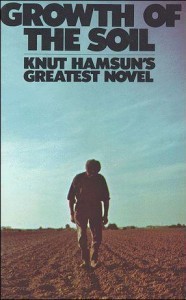
Growth of the Soil by Knut Hamsun is another not-that-holy book. However, Hamsun was one of the greatest and most influential authors of all time and his insight into elemental existence and human nature is mindblowing. “Growth of the Soil” is the book that secured him the Nobel Prize for literature in 1920, and it was the book the common man of the day valued more than any other of his works. Nazi Germany also printed the Growth of the Soil as special “field editions” to send with their soldiers to the fronts. From the book:
“And then things began to go swimmingly. It was in the days when womenfolk used to wear loose plaits in their hair; Andresen was the man to sell loose plaits. At a pinch, he could sell fair plaits to dark girls and be sorry he’d nothing lighter; no grey plaits, for instance, for that was the finest of all. And every evening the three young salesmen met at an appointed place and went over the day’s trade, each borrowing from another anything he’d sold out of; and Andresen would sit down, often as not, and take out a file and file away the German trade-mark from a sportsman’s whistle, or rub out ” Faber ” on the pens and pencils. Andresen was a trump and always had been.”
Download Growth of the Soil here (20.3MB/432 pages):
 Growth of the Soil by Knut Hamsun
Growth of the Soil by Knut Hamsun
Knut Hamsun: A Literary Giant with a Controversial Legacy
Exploring the works and life of one of Norway’s most influential authors.
For readers and scholars of modern literature, few figures evoke the mixed emotions that accompany the name Knut Hamsun. An undeniable giant in the literary realm, Hamsun’s groundbreaking narrative techniques and psychological depth made him one of the foremost authors of the early 20th century. Yet, his controversial political beliefs have often overshadowed his literary prowess.
From Humble Beginnings to Literary Acclaim
Born in 1859 in Lom, Norway, Hamsun led a life filled with hardship. His early years were marked by poverty, leading him to work various odd jobs across the U.S. and Scandinavia. This tumultuous period greatly influenced his writing, as he frequently explored themes of poverty, urbanization, and the human psyche’s intricacies.
Hamsun’s literary breakthrough came with his novel “Hunger” in 1890. The narrative, revolving around a struggling writer in Oslo, is often considered a precursor to modernist literature. With its stream-of-consciousness style and exploration of inner turmoil, “Hunger” announced Hamsun as a new literary force.
Throughout the subsequent decades, Hamsun penned several influential works, including “Mysteries,” “Pan,” and “Growth of the Soil” – the latter earning him the Nobel Prize in Literature in 1920.
A Modernist Pioneer
Hamsun’s work stood in stark contrast to the realistic novels that dominated the literary scene of his time. He delved deep into the human mind, exploring the irrational impulses and internal conflicts that shape individual actions. His characters, often isolated and introspective, grapple with the challenges of modernity and the tension between man and nature.
A Controversial Legacy
Despite his remarkable contributions to literature, Hamsun’s reputation was marred by his political beliefs. During World War II, Hamsun openly supported the Nazi occupation of Norway, and his meeting with Hitler further intensified the backlash against him. Post-war, Hamsun faced legal consequences for his association with the Nazis, casting a shadow over his illustrious career.
Hamsun in the 21st Century
Today, literary scholars and readers face the challenging task of separating Hamsun’s literary genius from his controversial personal beliefs. His novels remain fundamental in understanding the evolution of modernist literature, offering insights into the complexities of the human experience.
For those who delve into Hamsun’s world, they find a landscape rife with internal conflicts, raw emotion, and an unflinching portrayal of humanity. And while his legacy remains contentious, his place in the literary canon is undeniable.
As we leaf through the pages of history and literature, Knut Hamsun serves as a powerful reminder of the intricate relationship between art, the artist, and the socio-political context they inhabit.

This and his book Hunger are extraordinary. Along the lines of the great Russians, equally as expressive but stylistically stripped to the bare bones. Thanks for making it available!!
Without doubt a lot of efforts has gone into this and very commendable for making knowledge available to seekers of understanding. Good work. Kudos.